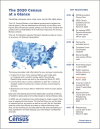The US Census and the People's Health: Public Health Engagement From Enslavement and "Indians Not Taxed" to Census Tracts and Health Equity (1790-2018)
- PMID: 31219723
- PMCID: PMC6611116
- DOI: 10.2105/AJPH.2019.305017
The US Census and the People's Health: Public Health Engagement From Enslavement and "Indians Not Taxed" to Census Tracts and Health Equity (1790-2018)
Abstract
Public health professionals have long played a vital-albeit underappreciated-role in shaping, not simply using, US Census data, so as to provide the factual evidence required for good governance and health equity. Since its advent in 1790, the US Census has constituted a key political instrument, given the novel mandate of the US Constitution to allocate political representation via a national decennial census. US Census approaches to categorizing and enumerating people and places have profound implications for every branch and level of government and the resources and representation accorded across and within US states. Using a health equity lens to consider how public health has featured in each generation's political battles waged over and with census data, this essay considers three illustrations of public health's engagement with the enduring ramifications of three foundational elements of the US Census: its treatment of slavery, Indigenous populations, and the politics of place. This history underscores how public health has major stakes in the values and vision for governance that produces and uses census data.
Figures




Similar articles
-
Potential Impact of 2020 US Decennial Census Data Collection on Disaster Preparedness and Population Mental Health.Am J Public Health. 2019 Aug;109(8):1079-1083. doi: 10.2105/AJPH.2019.305150. Epub 2019 Jun 20. Am J Public Health. 2019. PMID: 31219714 Free PMC article.
-
A century of census tracts: health & the body politic (1906-2006).J Urban Health. 2006 May;83(3):355-61. doi: 10.1007/s11524-006-9040-y. J Urban Health. 2006. PMID: 16739037 Free PMC article.
-
Destroyed by Slavery? Slavery and African American Family Formation Following Emancipation.Demography. 2018 Oct;55(5):1587-1609. doi: 10.1007/s13524-018-0711-6. Demography. 2018. PMID: 30218275
-
Coming to America: Regulatory Oversight of United States Immigration Policies: A Brief History.Pediatr Clin North Am. 2019 Jun;66(3):525-536. doi: 10.1016/j.pcl.2019.02.002. Pediatr Clin North Am. 2019. PMID: 31036232 Review.
-
Challenges to the census: international trends and a need to consider public health benefits.Public Health. 2017 Oct;151:87-97. doi: 10.1016/j.puhe.2017.05.015. Epub 2017 Jul 29. Public Health. 2017. PMID: 28759883 Review.
Cited by
-
Incidence rates of childhood asthma with recurrent exacerbations in the US Environmental influences on Child Health Outcomes (ECHO) program.J Allergy Clin Immunol. 2023 Jul;152(1):84-93. doi: 10.1016/j.jaci.2023.03.016. Epub 2023 Mar 25. J Allergy Clin Immunol. 2023. PMID: 36972767 Free PMC article.
-
Data linkage multiplies research insights across diverse healthcare sectors.Commun Med (Lond). 2025 Mar 4;5(1):58. doi: 10.1038/s43856-025-00769-y. Commun Med (Lond). 2025. PMID: 40038513 Free PMC article. Review.
-
American Indian Reservations and COVID-19: Correlates of Early Infection Rates in the Pandemic.J Public Health Manag Pract. 2020 Jul/Aug;26(4):371-377. doi: 10.1097/PHH.0000000000001206. J Public Health Manag Pract. 2020. PMID: 32433389 Free PMC article.
-
Disparities in infectious disease-related health care utilization between Medicaid-enrolled American Indians and non-Hispanic Whites-Lessons from the first 16 months of coronavirus disease 2019 and a decade of flu seasons.Health Serv Res. 2025 Feb;60(1):e14389. doi: 10.1111/1475-6773.14389. Epub 2024 Oct 10. Health Serv Res. 2025. PMID: 39390696 Free PMC article.
-
Relationship of political ideology of US federal and state elected officials and key COVID pandemic outcomes following vaccine rollout to adults: April 2021-March 2022.Lancet Reg Health Am. 2022 Dec;16:100384. doi: 10.1016/j.lana.2022.100384. Epub 2022 Oct 31. Lancet Reg Health Am. 2022. PMID: 36338898 Free PMC article.
References
-
- Anderson MJ. The American Census: A Social History. 2nd ed. New Haven, CT: Yale University Press; 2015.
-
- Schor P. Counting Americans; How the US Census Classified the Nation. New York, NY: Oxford University Press; 2017.
-
- Thorvaldsen G. Censuses and Census Takers: A Global History. London, UK: Routledge; 2017.
-
- Becker PC. Uses of the census and ACS: federal agencies. In: Anderson MJ, Citro CF, Salvo JJ, editors. Encyclopedia of the US Census: From the Constitution to the American Community Survey. 2nd ed. Thousand Oaks, CA: CQ Press; 2012. pp. 384–385.
-
- Gaines LM, Gage L, Salvo JJ. Use of the census and ACS: state and local governments. In: Anderson MJ, Citro CF, Salvo JJ, editors. Encyclopedia of the US Census: From the Constitution to the American Community Survey. 2nd ed. Thousand Oaks, CA: CQ Press; 2012. pp. 386–388.
Publication types
MeSH terms
LinkOut - more resources
Full Text Sources

